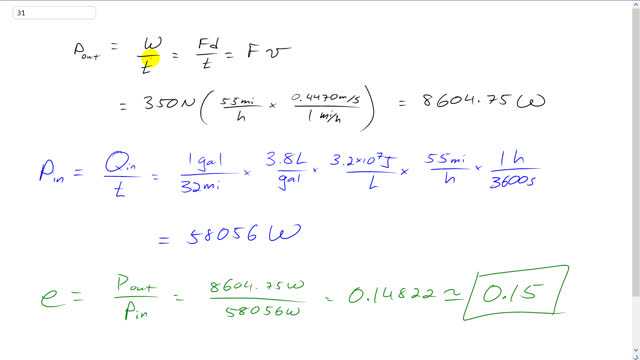
A typical compact car experiences a total drag force of about 350 N at 55 mi/h. If this car gets 32 miles per gallon of gasoline at this speed, and a liter of gasoline (1 gal = 3.8 L) releases about when burned, what is the car’s efficiency?

In order to watch this solution you need to have a subscription.
This is Giancoli Answers with Mr. Dychko. The first thing we need to know is the power output of the car and that's going to be doing as much work against friction as friction is doing on the car. So, or you could also say that the force of the car needs to exert forwards is going to equal the force that the friction is applying backwards so the power output then is the work done by the car per time which is the force that the car exerts multiplied by distance over time but distance over time is speed and the force the car exerts is gonna equal the force that friction exerts against it because it's going in constant speed and the force is balanced left and right. So that's gonna be 350 Newtons times 55 miles per hour times 0.4770 meters per second per mile per hour. I found this conversion factor in the front cover of the textbook and this gives 8604.75 watts. That's the power output of the car. The power input or the rate of energy consumed by the car to do this output work or output power is energy per time. It's useful to think about this in terms of units. We know the car consumes one gallon for every 32 miles. So I wrote it this way, instead of 32 miles per one gallon, I wrote it as as one gallon per 32 miles because I know I want some units that are in joules per second or energy per time. And this gallon, well, that's of course not an energy unit, it's a volume unit but we can turn it into energy because we know there's 3.2 times ten to the seven joules per liter of the gasoline and we can give it to gallons into liters by going 3.8 litres per gallon. And so now we have joules per mile. And then we have to turn this get some time units in the bottom so we multiply by 55 miles per hour. And now we have joules per hour. And then times by one hour for every 3600 seconds and we get joules per second. So this is the power input in Watts, 58056 watts. Efficiency is power output divided by power input. So, that's 8604.75 watts output divided by 58056 watts input and that's 0.15 efficiency.